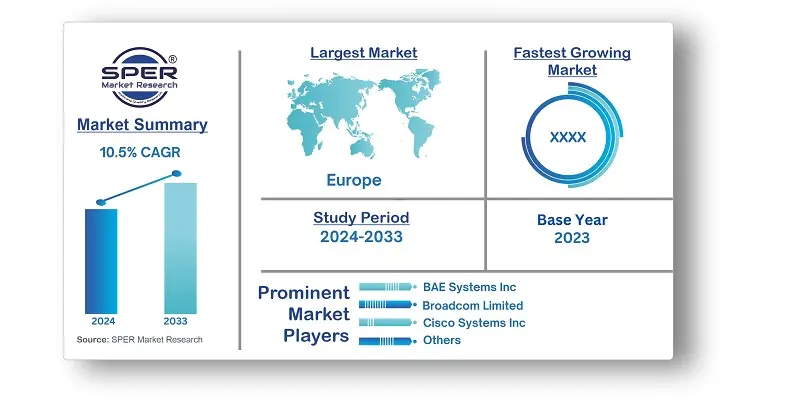
UK Cybersecurity Market Growth, Size, Trends, Share, Demand, Revenue and Future Outlook
UK Cybersecurity Market Size- By Offering, By Deployment, By End User, By Organization Size- Regional Outlook, Competitive Strategies and Segment Forecast to 2033
| Published: Apr-2024 | Report ID: IACT2465 | Pages: 1 - 105 | Formats*: |
| Category : Information & Communications Technology | |||
- February 2023: In order to deepen their cybersecurity cooperation, Jordan and the UK inked a memorandum of agreement. The British ambassador to Jordan, Bridget Brind, and Bassam Maharmeh, the director of Jordan's National Centre for Cyber Security, signed the agreement. The agreement, according to the NCSC, demonstrates the countries' commitment to preserving the economic, social, and security advantages of using a free and open cyberspace.
- January 2023: In order to provide clients with state-of-the-art solutions, Chorus and TD SYNNEX established a cyber security collaboration. The collaboration is essential to Chorus's ultimate goal of supporting clients and partners by establishing a Cyber Security Operation Centre in the UK that will make use of Microsoft Sentinel's advanced capabilities 24/7/365.


| Report Metric | Details |
| Market size available for years | 2020-2033 |
| Base year considered | 2023 |
| Forecast period | 2024-2033 |
| Segments covered | By Offering, By Deployment, By End User, By Organization Size |
| Regions covered | Eastern Region, Northern Region, Southern Region, Western Region |
| Companies Covered | BAE Systems Inc, Broadcom Limited, Cisco Systems Inc, Dell Technologies Inc., Fortinet Inc, IBM Corporation, Intel Security (Intel Corporation), Mcafee, LLC, Palo Alto Networks, Trend Micro Incorporated (UK), Others |
- Enterprises
- Government Agencies
- Financial Institutions
- Healthcare Providers
- Educational Institutions
- Others
| By Offering: |
|
| By Deployment: |
|
| By End User: |
|
| By Organization Size: |
|
- UK Cybersecurity Market Size (FY’2024-FY’2033)
- Overview of UK Cybersecurity Market
- Segmentation of UK Cybersecurity Market By Offering (Security Type, Services)
- Segmentation of UK Cybersecurity Market By Deployment (Cloud, On-premise)
- Segmentation of UK Cybersecurity Market By End User (BFSI, Government & Defense, Healthcare, IT and Telecommunication, Manufacturing, Other End Users)
- Segmentation of UK Cybersecurity Market By Organization Size (Large Enterprises, Medium Enterprises, Small Enterprises)
- Statistical Snap of UK Cybersecurity Market
- Expansion Analysis of UK Cybersecurity Market
- Problems and Obstacles in UK Cybersecurity Market
- Competitive Landscape in the UK Cybersecurity Market
- Impact of COVID-19 and Demonetization on UK Cybersecurity Market
- Details on Current Investment in UK Cybersecurity Market
- Competitive Analysis of UK Cybersecurity Market
- Prominent Players in the UK Cybersecurity Market
- SWOT Analysis of UK Cybersecurity Market
- UK Cybersecurity Market Future Outlook and Projections (FY’2024-FY’2033)
- Recommendations from Analyst
1.1. Scope of the report1.2. Market segment analysis
2.1. Research data source2.1.1. Secondary Data2.1.2. Primary Data2.1.3. SPER’s internal database2.1.4. Premium insight from KOL’s2.2. Market size estimation2.2.1. Top-down and Bottom-up approach2.3. Data triangulation
4.1. Driver, Restraint, Opportunity and Challenges analysis4.1.1. Drivers4.1.2. Restraints4.1.3. Opportunities4.1.4. Challenges
4.2. COVID-19 Impacts of the UK Cybersecurity Market
5.1. SWOT Analysis5.1.1. Strengths5.1.2. Weaknesses5.1.3. Opportunities5.1.4. Threats5.2. PESTEL Analysis5.2.1. Political Landscape5.2.2. Economic Landscape5.2.3. Social Landscape5.2.4. Technological Landscape5.2.5. Environmental Landscape5.2.6. Legal Landscape5.3. PORTER’s Five Forces5.3.1. Bargaining power of suppliers5.3.2. Bargaining power of buyers5.3.3. Threat of Substitute5.3.4. Threat of new entrant5.3.5. Competitive rivalry5.4. Heat Map Analysis
6.1. UK Cybersecurity Market Manufacturing Base Distribution, Sales Area, Product Type6.2. Mergers & Acquisitions, Partnerships, Product Launch, and Collaboration in UK Cybersecurity Market
7.1. UK Cybersecurity Market Value Share and Forecast, By Offering, 2024-20337.2. Security Type7.2.1. Cloud Security7.2.2. Consumer Security7.2.3. Data Security7.2.4. Identity Access Management7.2.5. Infrastructure Protection7.2.6. Network Security7.2.7. Other Types7.3. Services
8.1. UK Cybersecurity Market Value Share and Forecast, By Deployment, 2024-20338.2. Cloud8.3. On-premise
9.1. UK Cybersecurity Market Value Share and Forecast, By End User, 2024-20339.2. BFSI9.3. Government & Defense9.4. Healthcare9.5. IT and Telecommunication9.6. Manufacturing9.7. Other End Users
10.1. UK Cybersecurity Market Value Share and Forecast, By Organization Size, 2024-203310.2. Large Enterprises10.3. Medium Enterprises10.4. Small Enterprises
11.1. UK Cybersecurity Market Size and Market Share
12.1. UK Cybersecurity Market Size and Market Share By Offering (2020-2026)12.2. UK Cybersecurity Market Size and Market Share By Offering (2027-2033)
13.1. UK Cybersecurity Market Size and Market Share By Deployment (2020-2026)13.2. UK Cybersecurity Market Size and Market Share By Deployment (2027-2033)
14.1. UK Cybersecurity Market Size and Market Share By End User (2020-2026)14.2. UK Cybersecurity Market Size and Market Share By End User (2027-2033)
15.1. UK Cybersecurity Market Size and Market Share By Organization Size (2020-2026)15.2. UK Cybersecurity Market Size and Market Share By Organization Size (2027-2033)
16.1. UK Cybersecurity Market Size and Market Share By Region (2020-2026)16.2. UK Cybersecurity Market Size and Market Share By Region (2027-2033)16.3. Eastern Region16.4. Northern Region16.5. Southern Region16.6. Western Region
17.1. BAE Systems Inc17.1.1. Company details17.1.2. Financial outlook17.1.3. Product summary17.1.4. Recent developments17.2. Broadcom Limited17.2.1. Company details17.2.2. Financial outlook17.2.3. Product summary17.2.4. Recent developments17.3. Cisco Systems Inc17.3.1. Company details17.3.2. Financial outlook17.3.3. Product summary17.3.4. Recent developments17.4. Dell Technologies Inc17.4.1. Company details17.4.2. Financial outlook17.4.3. Product summary17.4.4. Recent developments17.5. Fortinet Inc17.5.1. Company details17.5.2. Financial outlook17.5.3. Product summary17.5.4. Recent developments17.6. IBM Corporation17.6.1. Company details17.6.2. Financial outlook17.6.3. Product summary17.6.4. Recent developments17.7. Intel Security (Intel Corporation)17.7.1. Company details17.7.2. Financial outlook17.7.3. Product summary17.7.4. Recent developments17.8. Mcafee, LLC17.8.1. Company details17.8.2. Financial outlook17.8.3. Product summary17.8.4. Recent developments17.9. Palo Alto Networks17.9.1. Company details17.9.2. Financial outlook17.9.3. Product summary17.9.4. Recent developments17.10. Trend Micro Incorporated (UK)17.10.1. Company details17.10.2. Financial outlook17.10.3. Product summary17.10.4. Recent developments17.11. Others
SPER Market Research’s methodology uses great emphasis on primary research to ensure that the market intelligence insights are up to date, reliable and accurate. Primary interviews are done with players involved in each phase of a supply chain to analyze the market forecasting. The secondary research method is used to help you fully understand how the future markets and the spending patterns look likes.
The report is based on in-depth qualitative and quantitative analysis of the Product Market. The quantitative analysis involves the application of various projection and sampling techniques. The qualitative analysis involves primary interviews, surveys, and vendor briefings. The data gathered as a result of these processes are validated through experts opinion. Our research methodology entails an ideal mixture of primary and secondary initiatives.



Frequently Asked Questions About This Report
PLACE AN ORDER
Year End Discount
Sample Report
Pre-Purchase Inquiry
NEED CUSTOMIZATION?
Request CustomizationCALL OR EMAIL US
100% Secure Payment






Related Reports
Our Global Clients
Our data-driven insights have influenced the strategy of 200+ reputed companies across the globe.




















